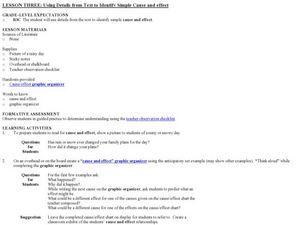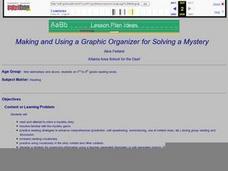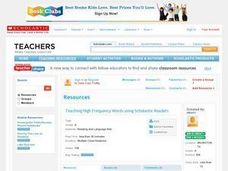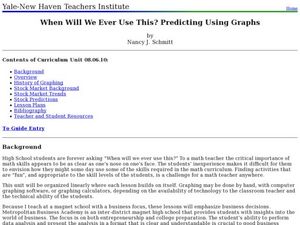Curated OER
Lesson Three: Using Details from Text to Identify Simple Cause and Effect
Third graders identify cause and effect. In this cause and effect lesson, 3rd graders use a graphic organizer to predict effects for certain causes. They read a non-fiction text and put sticky notes marking causes and effects.
Curated OER
Problem-Solving Processes and Figurative Language
Nonfiction texts about people on the move provide young readers with an opportunity to examine not only the problem-solving strategies employed by immigrants, but to also find examples of figurative language these writers use to tell...
Curated OER
Introducing Communication Talent with "Casey at the Bat"
Analyze the poem "Casey at the Bat." Your team of analysts will read the poem and complete a variety of activities, including describing how Casey looks and acts, describing how he feels before and after he strikes out, and sharing...
Curated OER
Making and Using a Graphic Organizer for Solving a Mystery
Students create tables in a word processing program which helps them organize their text clues when reading a mystery story. They develop reading comprehension strategies while using a computer based graphic organizer in order to solve...
Curated OER
Is the Moon out tonight?
Learners talk or read about the way the moon travels across the sky. They then look at the picture of where the moon is and draw where it will be in the picture, later in the evening. Note: The worksheet is intended for third or fourth...
Curated OER
Still Life Predictions
Third graders read part of the story "Balto, the Dog Who Saved Nome". They make predictions about the story ending and identify the picture clues and textual information they used to form their predictions. They discuss the story's ending.
Curated OER
Great Expectations: DRTA Strategy
A Directed Reading Thinking Activity (DRTA) strategy for Great Expectations scaffolds and guides readers as they begin Dicken's novel. Step-by-step directions are provided, as are chapter one pair-share questions, a prediction worksheet,...
Curated OER
What's Your Opinion
Students complete a questionnaire, formulating opinions on issues that be addressed in the novel, Sing Down the Moon. They make predictions about events that might occur in the novel based on the group discussion.
Curated OER
Growing Seeds: Making Predictions
In this prediction worksheet, students read statements on the left side of a graphic organizer about seeds and growing conditions, then predict in the right side of the column how much they think the seed will grow under each condition.
Curated OER
Predicting the Future
Students examine how scientists predict the effects of global climate change. In this environmental science lesson plan, students participate in a discussion about using computer generated data to create climate predictions. Students...
Curated OER
Teaching High Frequency Words
Study high frequency words and illustrate them with young scholars. They will use charts to practice the words. They will also do a picture walk with the book they are reading and use the high frequency words in sentences. In the end,...
Houghton Mifflin Harcourt
Wheels Go Around: Challenge Activities (Theme 7)
Wheels go around is the theme of this series of challenge activities. Extend learning of making predictions and the reading comprehension skill, cause and effect, through grand conversations, poster designing, and writing books.
Curated OER
When Will We Ever Use This? Predicting Using Graphs
Here are a set of graphing lessons that have a real-world business focus. Math skills include creating a scatter plot or line graph, fitting a line to a scatter plot, and making predictions. These lessons are aimed at an algebra 1 level...
Curated OER
Mucket Mania: The Mussel Industry in Arkansas
Middle and high schoolers read and discuss articles about the mussel industry in Arkansas. They pay close attention to the history of pearling and button making industries on the Black and White Rivers of Arkansas. This impressive,...
Reed Novel Studies
The True Blue Scouts of Sugar Man Swamp: Novel Study
Wild feral hogs and an alligator wrestler are just two interesting aspects of Kathi Appelt's novel The True Blue Scouts of Sugar Man Swamp. Using the novel study, scholars search the text for examples of the eight parts of speech....
Curated OER
You Make the Call: Practicing Predictions
In this worksheet on making predictions, students read 4 short scenarios that end with a question about what might happen next, then answer the question lines provided.
Curated OER
Reading Comprehension 3: Level 9
A statistics-loaded passage about home sales provides the text for a reading comprehension exercise. Although the subject matter might challenge some readers, the answer key explains how to approach and answer the three multiple choice...
Curated OER
Guided Reading -- If You Give a Mouse a Cookie
Students are read the book "If You Give a Mouse a Cookie" page by page and discuss their favorite types of cookies. They predict what they believe will happen next based on what has already happened in the story. They practice putting...
Curated OER
Red Herrings
Sixth graders make predictions while reading The Westing Game. In this prediction and mystery lesson, 6th graders identify red herrings while reading and compare those clues with their predictions. Students complete a series of...
Curated OER
Instill Inherent Reading Strategies
Marking the text can help transform novice readers into experts and enrich the reading experience
Curated OER
Food Chains: Integrating Science and Reading
Using a high interest science topic, like the food chain, can get students excited about reading, math, and more! A multitue of wonderful ideas that have cross-curricular connections.
Penguin Books
A Teacher's Guide to the Signet Classics Edition of H.G. Wells's The Time Machine
Imagine being able to travel back and forth in time! H.G. Wells uses that scenario in his novel The Time Machine to comment on what he saw as the flaws in Victorian society and the industrial age. This teacher's guide is one of the best...
Curated OER
Going Graph-y
Second graders listen to and dicuss the story Where the Wild Things Are. They play a pantomime game and act out various feelings so their classmates can guess. They listen for the frequency of certain words, and record their findings on...
Curated OER
Anticipation Guide: Life of Pi
Create an anticipation guide with your class for Life of Pi. They will have likely heard of the novel and maybe even seen the movie, but provide them with this guide to get them thinking. Eight statements are given, and your class...

























